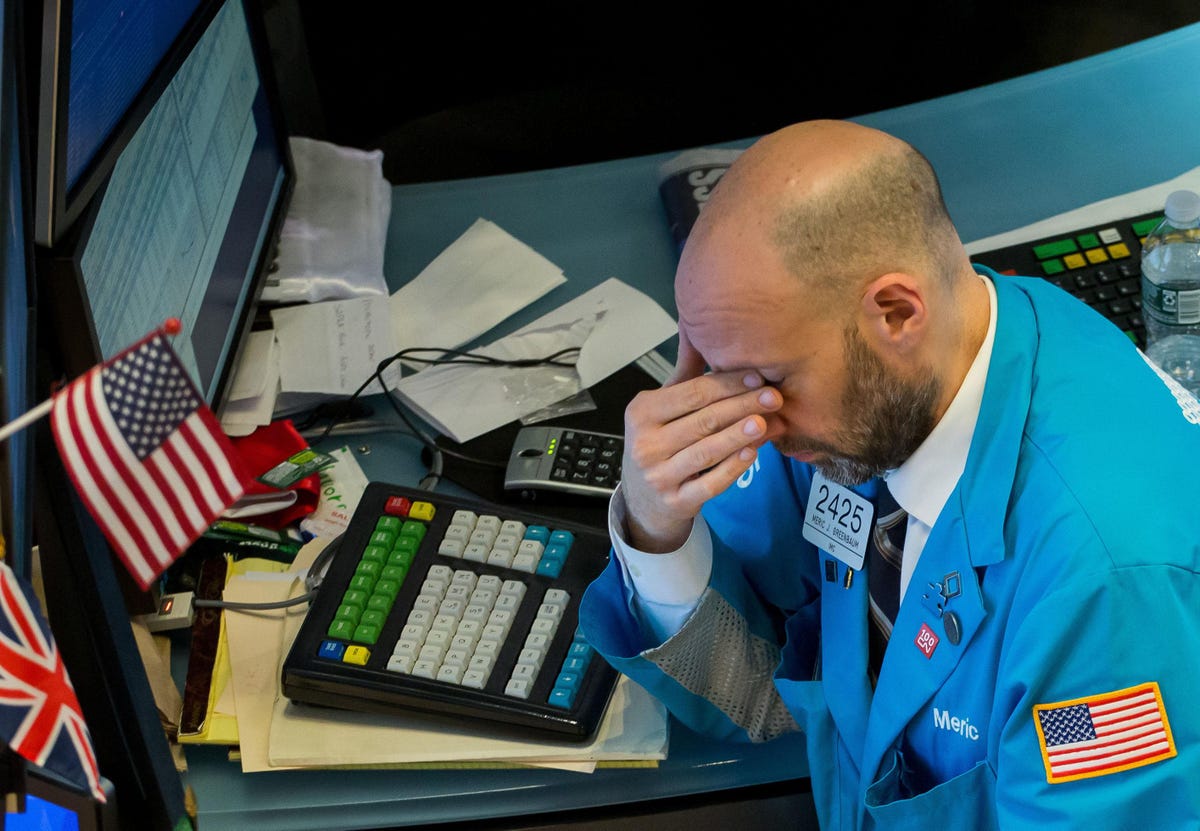
An exhausted trader at the New York Stock Exchange in New York. (Photo by Michael Nagle/Xinhua via … [+]
The S&P 500 went up every month since January. Some believe that this 7-month streak means that the market is too stretched. This is the view of those who tend to think that a healthy bull market has to be interspersed with breaks, while long uninterrupted runs make the market vulnerable to a sharp fall.
Concerns that the market rally may be at risk are compounded by the fact that the S&P 500 has not had a 20% decline – the classical definition of a bear market – since the financial crisis, when measured at month ends. Although it fell more than 20% between mid-February and mid-March last year, the monthly statements that investors get did not reflect that volatility. This is a good thing, because momentary, extreme moves can lead most people to close out positions at the worst possible moment. Non-professional investors are better off with a month-end approach.
As September rolls along, pundits insist on reminding everyone that September and October are bad months for the stock market. There is some justification for this, as October has had some awful returns such as in 2008 (-17%) and in 1987 (-21.8%). What is never mentioned is that it also had the best monthly return (in 1974, 16.3%) since the index was launched in 1957. In fairness, the worst month ever was September 1931, but this was before the S&P 500 index even existed, and during a very different economic and financial period of U.S. history. Here are some stats:
- Month that is up least often – September (45% of the time)
- Month that is up most often – Tie: April and December (73%)
- Month that is most often the year’s worse: August (16%)
- Month that is most often the year’s best: April (19%)
- Worst month ever: October 1987 (-21.8%)
- Best month ever: October 1974 (+16.3%)
What does this all mean? Very little, in fact. On one hand, September has been up less often than any other month and October had the worst result of any month. But before you use this to adjust your investments, note that December had never been the worst month in any year, even going all the way back to 1928, until December 2018 came along. The market fell that month more than 9%, which was the worst return of any month since February 2009. Also, after the Financial Crisis, September was the worst month of any year only once – in 2009, the same year that October was the best month of that year and remained the best month of any year for the next 10. The bottom line is that whatever September and October did in the past is not very useful to determine what they will turn out to be this year.
MORE FOR YOU
Worrying that the 7-month positive streak is a sign that pain is coming is also somewhat unjustified. The ten months from April 2017 through January 2018 were positive, for example, and then the market gained another 3% in 8 months.
Focusing on the performance of the index as a whole also overlooks the relative behavior of sectors, which offers a better insight into what the market is really doing. For instance, while it is true that the index has gone up for a long time without falling at least 20% (on a month-end basis), some sectors fell well in excess of 20% during that period, arguably flushing out some areas of excess. Some have noticed that even the seemingly invulnerable technology sector, despite the huge gains it enjoyed since the pandemic, fell well behind other sectors when the economy started to reopen last Fall. This may qualify for the cleansing that some investors like to see.
There are risks, of course, and they could hit sentiment before the end of October. One risk is related to the Delta variant of Covid-19, which has exacerbated the stubborn supply bottlenecks preventing the economy from running faster. Car manufacturers, for example, have been particularly hit by the shortage of chips originating in Asia and are suffering weaker sales simply because they don’t have enough cars to sell, despite very strong demand from consumers. Overall sentiment will suffer if these bottlenecks don’t start to ease in the weeks to come.
To some, a bigger worry is inflation. It has been running hotter than anticipated, and they fear that the Fed may tighten policy faster and harder than the market likes if inflation doesn’t ease up, which could be quite disruptive for stocks. The Fed keeps insisting that current inflation readings are temporary outliers, so it has been reluctant to commit to unwind its very loose monetary policy.
Recent reports, like the 235,000 new nonfarm jobs registered in August, seem to prove the Fed correct about keeping policy flexible, since the number was a huge miss from the 740,000 jobs analysts were expecting. But the fact that much of the miss was centered on the leisure and hospitality sector still places the blame on the persistent effects of Covid-19. On that front the outlook seems to be improving, ever so slightly, in states where public health has taken the worst hits such as Florida.
Given all the stimulus in the economy, the good prospects for an infrastructure bill and the overall good health of most consumers and businesses, if Covid-19 is indeed receding, the outlook for further stock gains is strong in the medium term, even if September and October are rocky.
What investors should do is resist the impulse to react to short-term volatility. Focusing on monthly statements is a good way to doing this. Or delegate the task of deciding how to react to episodic volatility to a trained professional that is less likely to lock in losses by overreacting.
A PERSONAL NOTE:
Today we remember 9/11/2001. I was living and working in Manhattan at the time, as a strategist for a major Wall Street firm. The day is seared in my memory – a day when I was lucky but thousands were not. Let us unite in honoring the memory of those who lost their lives that day. Let them rest in peace.







